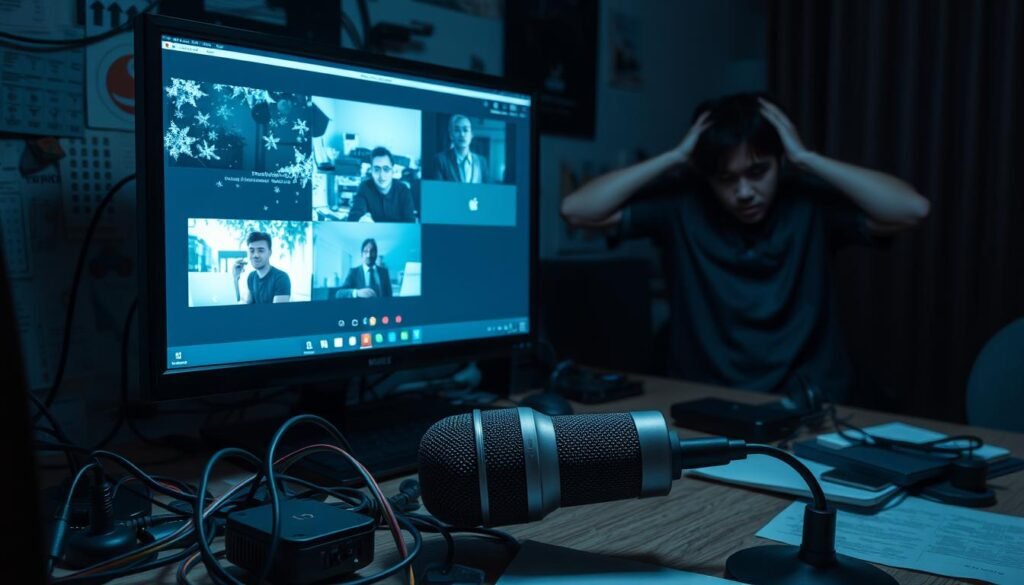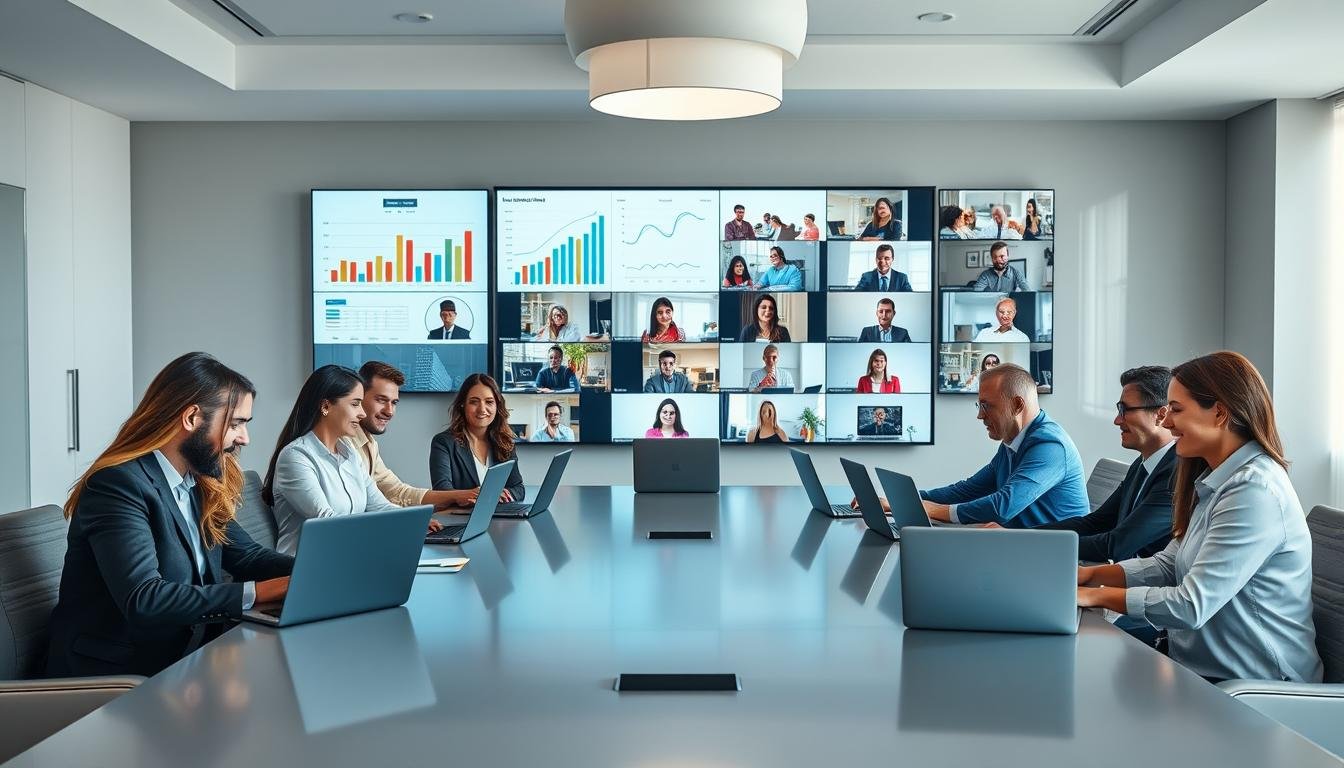Did you know that companies lose an average of $11,000 per employee each year due to ineffective communication? In today’s business landscape, mastering the art of the conference call has become essential for enhancing collaboration and streamlining business communication. As remote working continues to rise, virtual meetings have transformed from a novelty into a vital collaboration tool. Understanding how to conduct effective conference calls equips teams with the skills to maintain productivity and ensure productive discussions with colleagues, no matter where they are located.
Across various formats—including audio and video conferencing—each presents unique advantages to ensure successful interactions in the digital era. By embracing best practices, organizations can optimize their virtual meetings and foster a culture of engagement and efficiency. For more insights on effective practices, explore this comprehensive guide on conference call best practices.
Key Takeaways
- Most companies lose significant revenue due to poor communication.
- Effective conference calls enhance remote collaboration.
- Understanding various conference call formats can lead to improved discussions.
- Best practices are essential for successful virtual meetings.
- A well-planned agenda ensures a focused and productive call.
Understanding Conference Calls and Their Importance
In the current era, the quest for effective communication is paramount. The conference call emerges as a critical instrument, enabling multiple entities to converge in real-time, irrespective of their physical location. This modality of online assembly is instrumental in streamlining collaboration and decision-making processes.
What is a Conference Call?
Commonly denoted as a teleconference or audio conferencing, this communication technique empowers numerous individuals to engage in live discussions. Leveraging telecommunication advancements, participants can seamlessly integrate into the dialogue from their respective devices, thus transcending geographical barriers.
Benefits of Conference Calls
- Enhanced Collaboration: Facilitates the immediate exchange of ideas, thereby promoting teamwork.
- Cost-Effective: Reduces the necessity for physical travel, thereby conserving both time and financial resources.
- Increased Productivity: Empowers the scheduling of meetings with greater flexibility, accommodating a variety of schedules.
Moreover, the availability of diverse audio conferencing formats empowers corporations to refine their communication strategies, ensuring maximum efficiency in each assembly.
Types of Conference Calls
Varied contexts necessitate specific types of conference calls. These encompass:
- Audio Conferencing: Participants engage via telephone or internet audio.
- Video Conferencing: Offers a more intimate experience with the inclusion of visual elements.
- Webcasts: Ideal for broader audiences, integrating both audio and visual components.
Grasping these distinctions aids businesses in choosing the most suitable format for their requirements. For insights into privacy regulations impacting these technologies, refer to this link.
Preparing for a Successful Conference Call
The foundation of a successful conference call lies in meticulous preparation. A well-crafted strategy not only optimizes communication but also establishes a conducive environment for productive virtual interactions. It is imperative to concentrate on key elements to guarantee a seamless session.
Setting Clear Objectives
Defining clear, actionable objectives is paramount for steering the virtual meeting in the right direction. It is essential for participants to grasp the primary objectives, ensuring discussions remain pertinent. Objectives that are clearly articulated enable attendees to contribute meaningfully, fostering effective business communication.
Choosing the Right Technology
The selection of suitable technology is critical for a seamless and engaging conference call. Leveraging dependable collaboration tools can prevent technical hitches, thereby improving communication efficacy. Opt for platforms that cater to your team’s specific requirements—such as screen sharing, recording capabilities, and chat functionalities. For a comprehensive exploration of these options, refer to this resource.
Sending Invites and Agenda
Issuing timely invitations, accompanied by a comprehensive agenda, is indispensable for keeping participants abreast. Distributing these materials in advance enables thorough preparation, ensuring a focused and productive meeting. A well-structured agenda sets clear expectations, leading to enhanced engagement and outcomes during your successful conference call.
Best Practices for Conducting Conference Calls
Adopting optimal practices during conference calls can markedly elevate the efficacy of remote team communication. A variety of strategies are pivotal in crafting an environment conducive to productivity, managing time with precision, and ensuring active participation from all attendees. These factors are instrumental in fostering productive virtual meetings, where every participant’s contribution is acknowledged and valued.
Creating a Comfortable Environment
Establishing a serene atmosphere is paramount for the success of virtual meetings. It is imperative that all participants possess adequate technology and are proficient in its operation. Recommendations include:
- Opt for a location devoid of distractions, ensuring a conducive environment.
- Advise the use of headphones for enhanced audio clarity.
- Optimize lighting for optimal video call visibility.
Managing Time Effectively
Effective time management is vital for maintaining the focus and productivity of virtual meetings. Strategies to ensure a seamless meeting include:
- Define a clear agenda, allocating specific time slots for each topic.
- Designate a moderator to steer the discussion and maintain its relevance.
- Emphasize the importance of punctuality, starting and concluding on schedule as a gesture of respect for all attendees’ time.
Encouraging Participation
Creating a collaborative atmosphere is essential for enhancing remote team communication. To foster engagement, consider the following:
- Encourage all attendees to contribute their insights regularly.
- Employ open-ended questions to stimulate dialogue and encourage participation.
- Integrate breakout sessions for small group interactions during extended calls.
By adhering to these best practices, teams can circumvent common pitfalls associated with conference calls, ensuring that each participant feels integral to the discussion. This approach fosters a sense of unity and can lead to more effective outcomes. For additional insights on maintaining professionalism, refer to this guide on conference call faux pas.
Effective Communication Techniques
Effective communication is the cornerstone of successful virtual meetings. In discussions among remote teams, refining specific skills can dramatically improve the transmission and reception of messages. This segment delves into pivotal techniques that promote enhanced interaction.
Active Listening Skills
Active listening is a fundamental aspect of effective communication. It transcends mere auditory reception, encompassing a deep comprehension of the context and emotional undertones. To cultivate this skill, remote team communication strategies can include:
- Maintaining focus on the speaker by minimizing distractions.
- Using verbal acknowledgments like “I see” or “Go on” to indicate engagement.
- Summarizing key points after discussions to ensure clarity.
Using Clear and Concise Language
Clarity in communication is paramount, especially in virtual meetings where nonverbal cues are absent. Employing straightforward language is essential to prevent misinterpretations. To achieve this, consider these strategies:
- Avoiding jargon unless it is understood by all participants.
- Breaking down complex ideas into simpler concepts.
- Being direct and to the point, while still conveying the necessary information.
Handling Interruptions Gracefully
Interruptions can disrupt the flow of a discussion but managing them effectively ensures a smooth communication process. In remote team communication, employ these techniques:
- Establishing ground rules at the beginning of a meeting regarding turn-taking.
- Politely redirecting or acknowledging interruptions before moving back to the original speaker.
- Using a virtual hand-raising feature in video calls to maintain order.
Utilizing Technology to Enhance Calls
In the contemporary business milieu, where speed and efficiency reign supreme, the efficacy of communication stands paramount. The integration of technology into conference calls can markedly elevate their quality. The selection of appropriate conference call platforms is pivotal in ensuring the seamless execution of online meetings. Given the plethora of choices, it is imperative to discern the critical features and to guarantee a steadfast internet connection.
Choosing the Best Conference Call Platforms
In the quest for the optimal conference call platforms, one must meticulously consider the specific needs of one’s team and the inherent characteristics of the meetings at hand. Renowned platforms such as Zoom, Microsoft Teams, and Cisco Webex present distinct functionalities, catering to a broad spectrum of requirements. It is crucial to identify the platform that aligns most closely with your operational necessities, whether it pertains to extensive video conferencing or intimate gatherings.
Features to Look for in Software
In the pursuit of an enhanced video conferencing experience, it is imperative to seek out software with certain indispensable attributes. These include:
- Screen sharing functionalities for the presentation and dissemination of documents.
- Recording capabilities to facilitate the review of critical discussions at a later juncture.
- Security measures to safeguard confidential information during the course of the call.
- User-friendly interface to ensure universal accessibility for all participants.
Ensuring Reliable Internet Connection
A consistent and robust internet connection is indispensable for the success of online meetings. To preempt potential disruptions, consider the following strategies:
- Opt for a wired connection whenever feasible to enhance stability.
- Conduct a pre-meeting internet speed test to ascertain compliance with the platform’s specifications.
- Deactivate superfluous applications that may impede bandwidth during the conference.
- Prepare a contingency plan, such as a mobile hotspot, in anticipation of connectivity failures.
Dealing with Technical Challenges

Technical challenges can disrupt the flow of a conference call. Being prepared for issues such as connectivity problems or audio feedback can make a significant difference in maintaining productivity during meetings. Here’s a closer look at common technical hurdles, effective troubleshooting strategies, and insights on when to reach out for professional assistance.
Common Technical Issues
Participants often encounter various issues during conference calls, which include:
- Connectivity problems: Internet disruptions can lead to missed contributions.
- Audio feedback: This can create distractions and detract from the conversation.
- Video quality issues: Poor image resolution can hinder communication.
- Software compatibility: Different platforms may not work seamlessly together.
Troubleshooting Tips
Addressing technical challenges effectively requires proactive troubleshooting. Consider these tips:
- Test your equipment prior to the call to ensure everything is functioning properly.
- Join the call a few minutes early to resolve any last-minute issues.
- Mute your microphone when not speaking to minimize background noise and feedback.
- Switch to a wired connection if Wi-Fi issues occur, as it provides greater stability.
When to Seek IT Help
Some situations may require professional assistance. If the problems persist despite troubleshooting efforts, consider engaging IT support when:
- Multiple participants experience similar issues.
- Important meetings face significant disruptions affecting productivity.
- Unresolved technical challenges threaten the meeting’s objectives.
Following Up After the Call
The act of following up post-conference call is indispensable in solidifying the objectives previously discussed. This endeavor not only serves to elucidate pivotal points but also guarantees that all participants remain actively engaged and committed to their assigned tasks.
Summarizing Key Points
Efficient summarization of the primary ideas discussed facilitates participants’ understanding of their roles and the project’s trajectory. By highlighting these critical points in a subsequent email or document, expectations are clearly articulated, thereby averting potential misinterpretations.
Assigning Action Items
Establishing a list of actionable items is crucial for maintaining accountability. By assigning each task to a designated individual with precise deadlines, the completion of these duties is ensured. This methodical approach facilitates the monitoring of progress and sustains the meeting’s momentum.
Gathering Feedback
Seeking feedback from attendees post-call is instrumental in enhancing future meetings. Such input is invaluable, guiding improvements in the agenda, technology employed, or the format of the calls. Consequently, it leads to more efficacious and productive sessions.
Conference Call Etiquette

Attaining mastery over conference call etiquette is imperative for individuals engaging in virtual meetings. Engaging in appropriate professional conduct significantly enhances communication, thereby creating a respectful environment for all participants. The ability to maintain decorum during calls is pivotal for a productive discussion.
Professional Conduct on Calls
Exhibiting proper professional conduct during conference calls establishes a productive dialogue tone. Timeliness and thorough preparation are essential. It is crucial to share all necessary materials in advance to ensure a seamless meeting flow. When contributing to the conversation, address all participants with respect and refrain from interrupting others to foster a collaborative atmosphere.
Dress Code and Appearance
In a virtual setting, personal appearance remains significant. Adhering to a suitable dress code conveys professionalism and attention to detail. It plays a crucial role in setting the tone for the meeting, influencing participants’ perceptions. The choice of attire should be contextually appropriate, as it affects how one’s professionalism is perceived.
Respecting Time Zones
Scheduling calls with consideration for time zones promotes inclusivity and demonstrates respect for all participants. Utilizing tools that convert time zones facilitates easier scheduling for everyone involved. Ensuring calls are scheduled at times convenient for all participants fosters a positive collaborative spirit. For additional insights on conference call etiquette, refer to this resource.
Future Trends in Conference Calling
The evolution of workplace communication necessitates a deep understanding of the future trends in conference calling. The ascendance of hybrid meetings stands out, merging in-person and virtual attendance seamlessly. This evolution mirrors the shifting paradigms of team collaboration, offering flexibility and inclusivity to all participants, irrespective of their geographical location.
Rise of Hybrid Meetings
Hybrid meetings, integrating both in-person and remote attendees, are redefining the modern workplace. Organizations are embracing this format to boost engagement and participation, ensuring that team members from diverse backgrounds can contribute equally. This trend underscores the imperative of creating inclusive environments where every voice is valued, thereby nurturing a collaborative ethos.
Advancements in Virtual Reality
Virtual reality advancements are poised to transform virtual collaboration, offering immersive environments that mimic face-to-face interactions. This innovation promises to make meetings more engaging and productive. As businesses delve into these technologies, virtual ‘meeting rooms’ will become ubiquitous, bridging the gap between traditional conference calls and the desired sense of presence.
The Shift to AI-Powered Tools
The trend towards AI-powered tools is another pivotal shift in conference calling. These technologies aim to automate scheduling, note-taking, and follow-ups, thereby enhancing efficiency. As productivity becomes a paramount concern, the integration of AI functions will be indispensable for keeping abreast of modern communication demands. For a comprehensive analysis, refer to this report on the future of conference calls.
As we progress, grasping these emerging trends—hybrid meetings, virtual reality enhancements, and AI-powered tools—is vital for businesses seeking to enhance communication. The metamorphosis in our connectivity underscores the technological progress that influences our interactions, ensuring that every voice is heard in the digital era.
